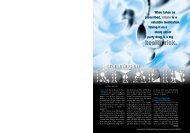Research Paper
Research Paper
Research Paper
You also want an ePaper? Increase the reach of your titles
YUMPU automatically turns print PDFs into web optimized ePapers that Google loves.
Writer’s Model<br />
<strong>Research</strong> <strong>Paper</strong><br />
This Writer’s Model has been formatted according to<br />
the standards of the MLA Handbook for Writers of<br />
<strong>Research</strong> <strong>Paper</strong>s, Fifth Edition.
Writer’s Model | <strong>Research</strong> <strong>Paper</strong> | Copyright © by Holt, Rinehart and Winston. All rights reserved.<br />
Lori Johnson<br />
Ms. Li<br />
Language Arts 10<br />
30 August 2000<br />
Forgotten Heroes<br />
“I felt freedom in my bones” (Fincher 52). Those are the words of escaped slave Elijah Marrs as<br />
he stripped away his old rags and donned his new army blues. Marrs was only one of nearly 180,000<br />
African American soldiers who served in the Union Army during the Civil War (Fincher 52). African<br />
American soldiers faced a struggle. Although they experienced discrimination, they served with great<br />
courage, and their effect on the United States was profound.<br />
From the very beginning of the Civil War, African American soldiers attempted to enlist in the<br />
Union Army. At first, they were rejected. At the time, most Northern whites were prejudiced against<br />
African Americans and believed they were not bold enough to fight (McPherson 52). Initially, Abraham<br />
Lincoln was opposed to the idea. He believed that African American soldiers would anger the border<br />
states, causing them to turn against the Union (McPherson 52).<br />
In 1862, however, as the North lost several major battles and morale began to drop, public opin-<br />
ion began to change. In the fall of 1862, Lincoln authorized the formation of the first African American<br />
regiments: the First South Carolina Volunteers (McPherson 53) and the First Kansas Colored Volunteers<br />
(Carle 79).<br />
On January 1, 1863, Lincoln issued the Emancipation Proclamation; slaves who escaped to the<br />
North were legally considered free citizens. After the proclamation, blacks could be recruited for the<br />
Union Army (McPherson 20). Of course, if the North did not win the war, the proclamation would be<br />
worthless. Historian Barbara Fields notes that African American soldiers knew that “the Emancipation<br />
Proclamation did nothing to get them their freedom. It said they had a right to put their bodies on the<br />
line if they had the nerve to believe in it” (The Civil War).<br />
Johnson 1<br />
Even though African Americans joined the Union Army, they continued to experience subtle
Writer’s Model | <strong>Research</strong> <strong>Paper</strong> | Copyright © by Holt, Rinehart and Winston. All rights reserved.<br />
and blatant discrimination. Men in these regiments received 10 dollars a month and no clothing<br />
allowance. In addition, African American soldiers could not serve as officers. In practice, the African<br />
American regiments often received inferior arms and ammunition. White doctors refused to serve with<br />
the regiments, and African American soldiers died of disease at a much higher rate than white soldiers<br />
(Ward, Burns, and Burns 253).<br />
It was risky for African American soldiers to enlist in the Union Army. Angry at the idea of<br />
African American troops, the Confederate forces would not allow them to surrender. Instead, they were<br />
shot or enslaved (Ward, Burns, and Burns 335). At the fierce Battle of Fort Pillow, hundreds of black<br />
soldiers were massacred after they surrendered (“Fort Pillow”).<br />
Discrimination and risk did not dampen the enthusiasm of the African American soldiers. In<br />
battle after battle, the soldiers showed great courage. At Fort Wagner, South Carolina, the Fifty-fourth<br />
Massachusetts led the attack on the Confederate stronghold. Half of the six hundred volunteers were<br />
killed, wounded, or captured; one soldier, Sergeant William Carney, became the first African American<br />
soldier to win the Congressional Medal of Honor (Fincher 56).<br />
The courage shown by the Fifty-fourth Massachusetts at Fort Wagner is one of the great<br />
moments in American military history. A reporter of the time made this comment: “[. . .] if this<br />
Massachusetts 54th had faltered when its trial came, 200,000 troops for whom it was a pioneer would<br />
never have been put into the field, but it did not falter. It made Fort Wagner such a name [. . .] as Bunker<br />
Hill [. . .]” (The Civil War).<br />
In battle after battle, African American soldiers displayed great bravery and heroism. Their<br />
courage changed the way that some Northerners viewed them. Assistant Secretary of War Charles Dana<br />
said that “the bravery of blacks in the battle at Milliken’s Bend completely revolutionized the sentiments<br />
of the Army” (Fincher 54). General Butler said, “I swore to myself a solemn oath [. . .] ‘to defend the<br />
rights of those men who have given their blood for me and my country that day and for their race<br />
Johnson 2<br />
forever’” (Fincher 60-61). Bruce Catton, author of The Centennial History of the Civil War, describes the<br />
change: “Under the revolution involved in the act of changing slaves into free men, even into soldiers,
Writer’s Model | <strong>Research</strong> <strong>Paper</strong> | Copyright © by Holt, Rinehart and Winston. All rights reserved.<br />
there lay a profounder [sic] revolution involving the way individual men looked at their fellow human<br />
beings” (120).<br />
The service of African Americans in the Civil War had two other profound effects. For one thing,<br />
the experience “contributed to the development of their racial pride and self-respect” (McPherson 96).<br />
For another, “the blacks’ struggle to get fair treatment from the military began to quicken their drive for<br />
equal rights in civilian life” (McPherson 96).<br />
Despite constant discrimination, African American soldiers fought courageously under adverse<br />
conditions and helped change forever the social fabric of the United States. For many years, the country<br />
was slow to acknowledge its debt to the African American soldier. In September 1996, a major memorial<br />
to honor African American soldiers who served in the Civil War was dedicated in Washington, D.C. As<br />
part of the memorial, the names of 178,000 African American soldiers and 7,000 officers who served with<br />
them are inscribed on stainless steel plaques (Grant).<br />
Today, the somber monument of steel and stone stands mute. The words of Commander<br />
Carleton Philpot, describing the men of the Ninth and Tenth Cavalry regiments, are a fitting tribute for<br />
African American soldiers of the Civil War: “This is a group of heroes—true heroes that you don’t have<br />
to create. Not football players, not singers, just guys who did a tough job and nobody gave a hoot”<br />
(Spiller 86).<br />
Johnson 3
Writer’s Model | <strong>Research</strong> <strong>Paper</strong> | Copyright © by Holt, Rinehart and Winston. All rights reserved.<br />
Works Cited<br />
Carle, Glenn L. “The First Kansas Colored.” American Heritage Feb.-Mar. 1992: 79-91.<br />
Catton, Bruce. The Centennial History of the Civil War. Vol. 3. Garden City: Doubleday, 1965.<br />
The Civil War. Dir. Ken Burns. Videocassette. PBS Video, 1990.<br />
Fincher, Jack. “The Hard Fight Was Getting into the Fight at All.” Smithsonian Oct. 1990: 46-61.<br />
“Fort Pillow.” ENCARTA Multimedia Encyclopedia. CD-ROM. Redmond: Microsoft, 1994.<br />
Grant, Linda. Telephone interview. 26 Apr. 1996.<br />
McPherson, James M. Marching Toward Freedom: Blacks in the Civil War 1861-1865. New York: Facts<br />
on File, 1991.<br />
Spiller, Roger J. “Honoring the Buffalo Soldiers.” American Heritage Feb.-Mar. 1992: 84-86.<br />
Ward, Geoffrey C., Ken Burns, and Ric Burns. The Civil War: An Illustrated History. New York: Knopf,<br />
1990.<br />
Johnson 4
Writer’s Guide | <strong>Research</strong> <strong>Paper</strong> | Copyright © by Holt, Rinehart and Winston. All rights reserved.<br />
Definition<br />
Conclusion<br />
■ Restate your thesis.<br />
■ Leave your readers with an<br />
insight.<br />
Writer’s Guide 5<br />
A research paper informs readers about an interesting, new, or important topic. It usually presents<br />
one main idea and supports that idea by using facts, examples, statistics, quotations, and<br />
other evidence taken from reliable sources such as books, magazines, the Internet, movies, and<br />
interviews.<br />
Many research papers use the structure illustrated in the framework below. Print this framework<br />
and use it as a guide when you write your own research paper.<br />
Framework Directions and Explanations<br />
Introduction<br />
■ Arouse interest with an<br />
attention-getter.<br />
■ Include your thesis statement.<br />
■ Suggest which aspects of the<br />
topic your paper covers.<br />
Body<br />
■ Develop your first main point<br />
with related supporting<br />
details.<br />
■ Develop each of your<br />
additional main points with<br />
related supporting details.<br />
Make a good first impression Hook your readers at<br />
the beginning of your paper. You can use a thoughtprovoking<br />
quotation, an anecdote, or an interesting<br />
description.<br />
Create a thesis to remember Present your main idea<br />
about the topic. A thesis statement can be more than<br />
one sentence, but try to make it as concise as possible.<br />
Guide your readers Let your readers know what to<br />
expect from your paper. Indicate the main points that<br />
you will discuss in your paper.<br />
Develop your information Develop each of your<br />
main points, supporting each one with evidence. Give<br />
examples or draw conclusions from your research, and<br />
be sure to cite sources.<br />
Final impression Sum up your main idea by restating<br />
your thesis, and present a final thought about your<br />
research. You can include relevant or interesting information<br />
that did not fit into the body of your paper.

















